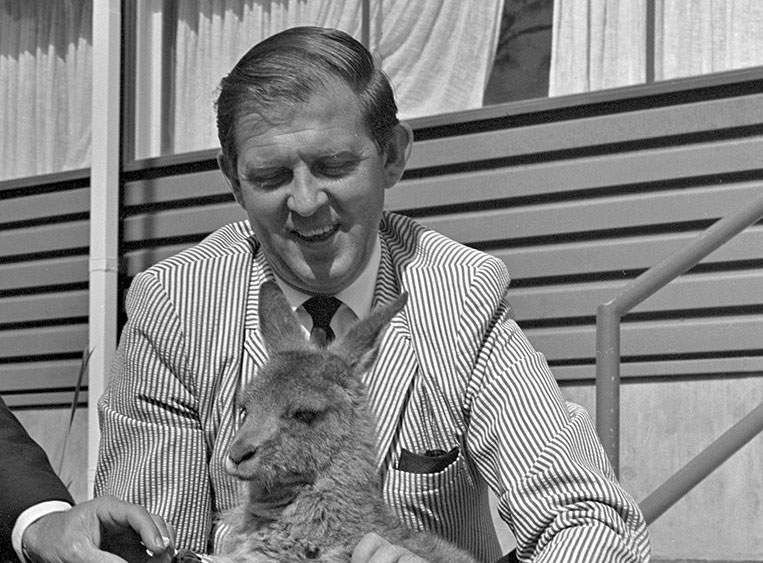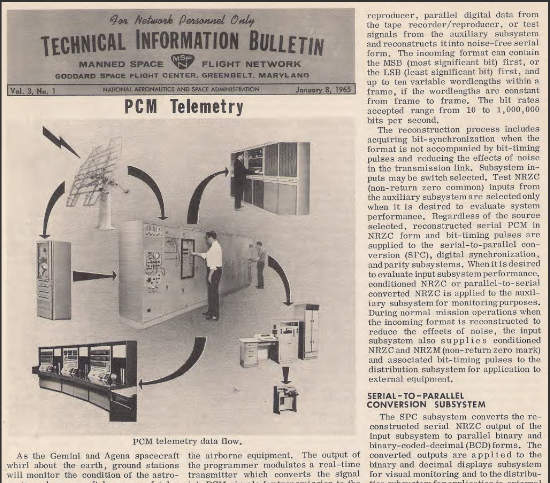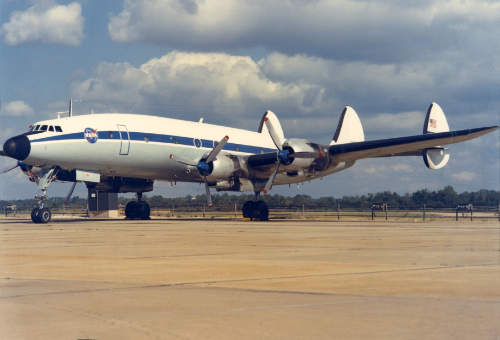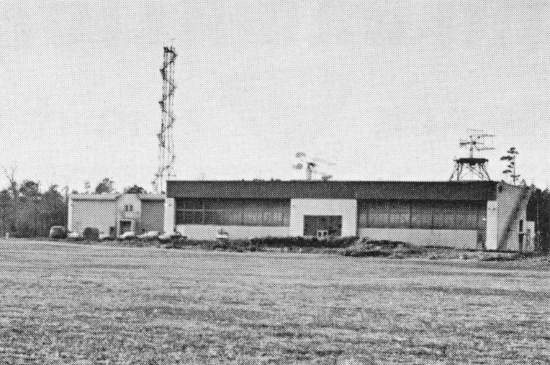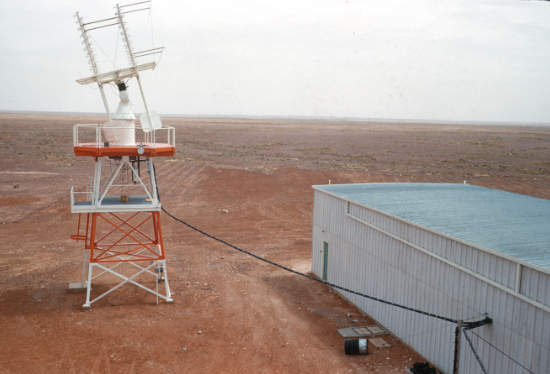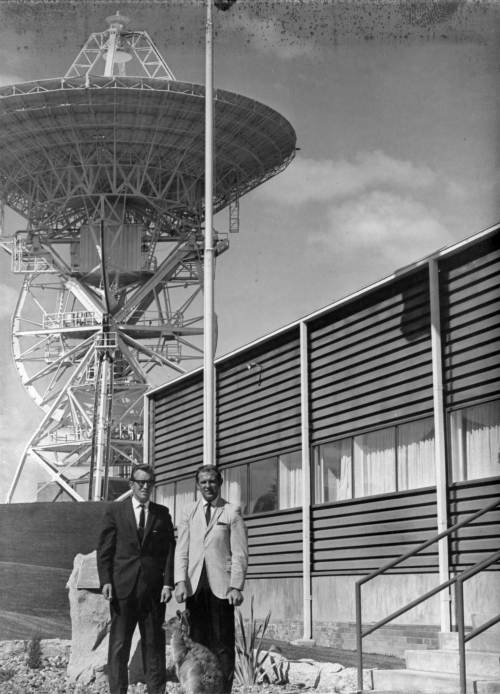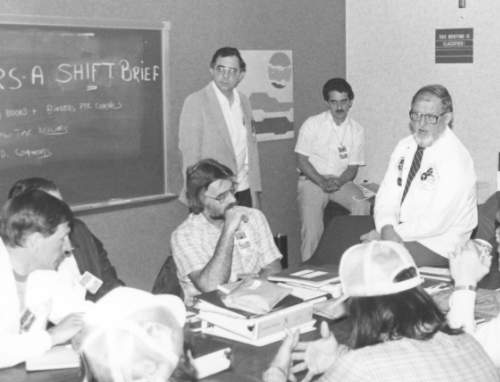1929 – 2025
MSFN development and the Goddard Simulation Flights
|
At Honeysuckle Creek on 29 September 1967, Goddard Space Flight Center Test Conductor George Harris Jr. (right) is presented with a plaque and a pair of sandals by Station Director Tom Reid at the conclusion an aircraft simulation visit.
Photo by Hamish Lindsay. |
George Harris was born in the market town of Willenhall in England’s West Midlands in 1929.
After studying Electrical Engineering, he moved to Canada and AVRO Aircraft in Malton, Ontario (1954-1959). Initially he was Flight Test Observer on the AVRO CF-100 Canuck jet fighter, conducting airborne tests of on-board Telemetry recording systems. From there he was appointed team leader for design and implementation of the control centre for real time monitoring of the AVRO Arrow, the advanced CF-105 jet interceptor. [1]
After the shock cancellation of the AVRO Arrow programme in 1959 by the Canadian Prime Minister, many highly qualified engineers found themselves looking for alternative work.
George obtained a job with North American Aviation in Columbus, Ohio. Two of his AVRO colleagues, John Hodge and Tecwyn Roberts, moved to the newly-formed NASA, which was looking for engineers to work on the upcoming ‘Man in Space’ program. Within a year, on the recommendation of Hodge and Roberts, who had started at NASA’s Langley Field, Virginia, Harris was offered a position with NASA. And so he became one of the thirty-two AVRO Canada people who were recruited by NASA to work on Project Mercury. [2] He remembers, “NASA titled us as the NASA CANADIANS”. [3]
George remembers, “John and Tec went to the Mercury Spacecraft project and I went to the Tracking and Data group and started what became the MSFN [Manned Space Flight Network]. I was assigned the Test and Checkout of the Mercury Network 19 stations around the world. I had a group that included two DC 4 aircraft and crews.” [1]
Based out of the Goddard Space Flight Center in Greenbelt, Maryland, these aircraft had the job of flying over the tracking stations and simulating the signals from a Mercury spacecraft to calibrate equipment and develop procedures.
The entire Mercury network was built between April 1960 and March 1961, and Harris and his team travelled worldwide to get the Mercury network ready for the first flights.
|
The Mercury Space Tracking and Communication Networks for MA-8, October 1962.
Large, Larger (4.8MB).
Jack Duperouzel at Muchea preserved this poster showing both the Mercury Space Tracking Network and the Mercury Communications Network as they were for Wally Schirra’s flight.
Scanned and assembled by Colin Mackellar. |
In Australia, the Weapons Research Establishment expressed a desire to do the calibration work with local crews using a WRE C47 Dakota. Harris oversaw the installation of the necessary equipment at WRE Salisbury, South Australia, as well as the training of the aircraft crew and station personnel. He was accompanied by Bendix Radio engineer Danny Dalton.
|
George Harris (left) and Australian Flight Officer Bob Dunnett standing alongside the NASA equipment which had just been installed in the WRE C47 Dakota.
With thanks to George Harris for both photos. |
The tragic loss of the Australian aircraft on 31 July 1961 meant that the NASA aircraft returned to Australia in preparation for MA-5 (Enos the Chimp) and MA-6 (John Glenn in Friendship 7).
After Mercury, George’s next task was Project Manager for the build and installation of the PCM system at the world wide stations for Project Gemini, and then the run up of the new Unified S-Band stations for Apollo.
|
Volume 3, No 1 of the MSFN Technical Information Bulletin (January 8, 1965) gives an overview of the new PCM Telemetry system. Preserved by John Lambie. |
|
Engineer Trevor Housley at Carnarvon’s Gemini Digital Command System (DCS – Mark 2).
This copy preserved by Lewis Wainwright. |
In preparation for Apollo, NASA instrumented Lockheed C-121G Super Constellations to simulate passes and monitor station performance and procedures.
|
Super Constellations NASA 420 and NASA 421 excercised the stations of the Manned Space Flight Network in the run up to, and during, Apollo. This is NASA 421. (Note the kangaroo decoration added on one of the Australian trips!)
Photo courtesy George Harris. |
Several such flights and associated teams of observers visited Honeysuckle Creek in 1967.
George Harris was Test Conductor for simulations involving Super Constellation NASA 421 in June of that year.
These sims revealed that Honeysuckle was falling behind in preparations, both in terms of management and discipline. High level discussions in the Department of Supply resulted in personnel changes at the station. The most obvious of these was that Thomas Reid, the Station Director at Orroral Valley, was brought in to fill that role at Honeysuckle.
Reid and Harris had met years before in Virginia. At the time, Reid was Senior Scientific Officer at Range E and Red Lake, Woomera. When NASA proposed building a Mercury Telemetry and Acquisition station near the existing WRE FPS-16 Radar, he was sent to the Langley Research Center in Virginia, and associated centres, to become familiar with what would be required.
Tom Reid remembered, “I first met George on Chincoteague [not far from NASA’s Wallops facility] during 1960, when we worked together on testing ground systems for Project Mercury.” [4]
|
Building N-161, home of the Manned Space Flight Network Training program at Wallops Station in the Chincoteaque-Assateague area of Virginia.
From page 2 of the MSFN Technical Information Bulletin Volume 1, Number 1, March 8, 1963. |
|
The Red Lake Telemetry and Acquisition station north of Woomera shortly after construction, looking North.
Transparency from the Tidbinbilla archives. |
In late June 1967, former Tidbinbilla StaDir Bob Leslie (now heading the American Projects Branch of the Department of Supply), received Harris’ report about Honeysuckle’s lack of preparedness. Leslie had already been concerned about Honeysuckle’s progress and appealed to his superiors in the Weapons Research Establishment to make changes at the station. He remembered, “I then recommended that Tom Reid should transfer from Orroral Valley to … pull the station into order. The outstanding performance of Honeysuckle in the Apollo missions is a tribute to how well he achieved that goal.” [4]
Other personnel changes were made, including the transfer of Tidbinbilla Deputy Director Mike Dinn to the equivalent position at Honeysuckle.
Tom Reid began as Station Director at Honeysuckle Creek on 7th August 1967. When George Harris and his simulation team returned to the station on 18th September, George was able to work with a Station Director he already knew.
(Hamish Lindsay recounts Harris’ second visit to the station with NASA 421.)
|
On 29 September 1967, Honeysuckle Station Director Tom Reid and Simulation Team Test Conductor George Harris Jr. pose for Hamish Lindsay’s camera at the conclusion an aircraft simulation visit. The station mascot is with them.
Photo by Hamish Lindsay. |
George Harris recalls the Apollo preparations, “When this task was close to complete, the ESA NASA representative asked the MSFN management if they could have me go to Darmstadt Germany and bring their OCC up to support level and train the ESRO team of Flight Controllers and act as Flight Director for the ESA missions.”
|
George Harris (right) as Mission Director in Darmstadt for the HEOS mission.
“HEOS-1 (Highly Eccentric Orbit Satellite-1) was the first European spacecraft to venture beyond near-Earth space, in order to study the magnetic fields, radiation and the solar wind outside of the Earth’s magnetosphere.” – Information: ESA.
With thanks to George Harris. |
Thus, Harris left NASA and he and his wife Martha moved to Germany, returning to the USA in early 1975 to a position with the Landsat program as Manager of R&D at the USGS’s EROS Data Center in South Dakota.
In 1979 he was offered a post at White Sands as Ops manager in support of TDRSS (Tracking and Data Relay Satellite System). The first TDRS failed to reach geostationary orbit after its deployment from the cargo bay of STS-6 in 1983. Harris was flight director of the White Sands recovery team which shepherded the satellite to its correct orbit over several months, thus saving the TDRSS program.
|
George Harris (right) and part of the Shift team working on the TDRS-A rescue. |
|
Captain Daniel Brandenstein who served as STS-8 Pilot in September 1983 is pictured with George during a visit to White Sands. |
In 1985 Harris left to work with Intelsat in France on the integration and launch of communication satellites using Ariane vehicles, returning to the USA in 1998.
This was followed by a spell as mission Flight Director at the Canadian Space Agency Control Center in Montreal, providing support to the RADARSAT mission to map Antarctica.
George officially retired in 2001, though continued in consultancy for some time, and says he misses the space business to this day.
___________
Notes:
1. Supplied by George Harris, and information from the book “Arrows to the Moon” by Chris Gainor. Apogee Books, 2001.
2. e-mail from George Harris, February 2024.
3.
e-mail from George Harris, November 2024.
4. e-mail from Tom Reid, February 2009.
5. Bob Leslie undated (early 1990s) interview with Ray Lloyd.
With grateful thanks to George for his story and the loan of his photos.
Scans by Colin Mackellar unless otherwise indicated.

